The Huawei Mate 8 Review
by Andrei Frumusanu on January 5, 2016 1:00 PM EST- Posted in
- Mobile
- Smartphones
- Huawei
- Cortex A72
- Kirin 950
- Mate 8
- CES 2016
Display Measurement
The Mate 8 sports a 6” diameter 1080 x 1920 pixel resolution screen manufactured by JDI. This is again an IPS-Neo LCD screen which is supposed to offer higher contrast ratios compared to other LCD technologies. The display driver IC is NovaTek’s NT35695, the same one found in other devices such as last year’s Mate 7, the P8 or HTC One M8. The DDIC supports and is run in MIPI command mode, thus supporting panel self-refresh (PSR).
It actually seems as that the Mate 8 employs a very similar, if not actually the same display as the one found on the Mate 7 as at first glance it’s hard to distinguish between the two screens as they both seem to offer the same viewing experience. This also includes the same viewing angles as found on the Mate 7, which offered one of the best experiences among LCD devices.
Huawei went with an AMOLED screen on the Mate S which offered substantially better viewing angles and overall display experience, but came at a price of extremely high power consumption as Huawei opted to use a less efficient display panel from Samsung. For the Mate 8, I think that sticking with an LCD was a wise choice as the Mate series is focused on battery life and such a large AMOLED display would have limited the device’s power efficiency.
2015 was a year where we saw the mainstream adoption of 1440p screens in many flagships, so it’s a bit odd to have Huawei still go with 1080p on the Mate 8. While this is a completely subjective matter and for many people the resolution is enough, I would have liked to see some improvement as 1080p on a 6” display such as the Mate 8 is stretching it quite a bit and visible to me when holding the device close up at about 25cm. Here’s hoping next year’s Mate manages to make the switch to 1440p.
Our display testing is done with an X-Rite i1Pro 2 spectrophotometer as our measurement hardware, in conjunction with SpectraCal's CalMAN software suite and our own workflow to be able to get an accurate display characterization.

In terms of maximum brightness the Mate 8 gets pretty bright as it’s able to show a luminosity of up to 522 cd/m². This is slightly higher than the Mate 7 and on par with some of the brightest LCD displays on current smartphones.

The black levels on the Mate 8 are slightly worse than the ones found on the Mate 7 – this is partly due to the fact that the Mate 8 gets brighter but I also think there are small differences in the panel itself. For example, the Mate 8 is much more homogeneous and displays less backlight bleeding than the Mate 7, especially around the edges of the display.
At minimum brightness the black levels reach very low values so the IPS-Neo panel is able to perform well in terms of maintaining high contrast at low luminosities. I was a bit disappointed that the minimum luminosity reached only 10 cd/m², which can still be quite bright when browsing in bed at night. I think the low value of 2 cd/m² targeted by other manufacturers is a sweet spot for comfortable night viewing, and as I’ve mentioned in past Huawei reviews, I’m still hoping that we’ll be eventually able to see this change in future devices from the company.
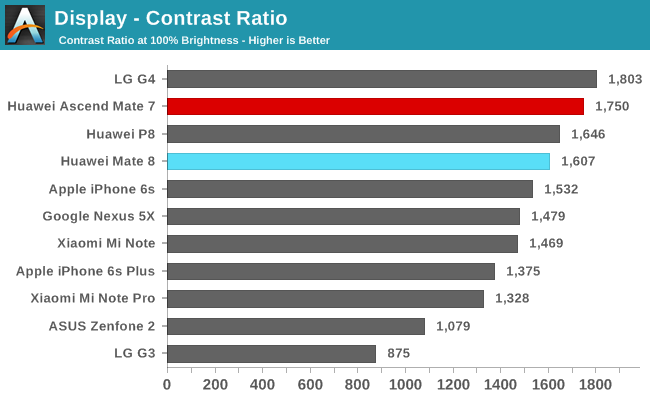
Contrast ratio ends up at 1607:1 at maximum brightness, a good value in itself but still a bit lower than the Mate 7. I wonder if Huawei will in the future make more usage of AMOLED panels as it would greatly benefit this aspect of the device display quality.
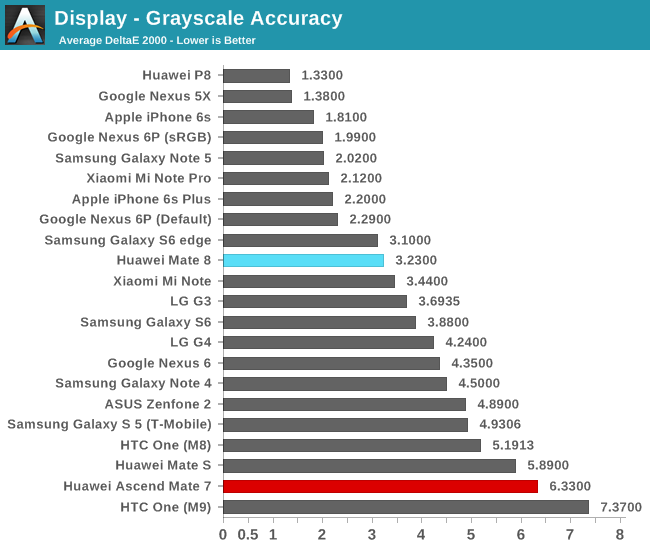
Moving on onto the grayscale accuracy testing we see the Mate 8 performs averagely. At 200 nits the average gamma is higher than the desired 2.2 target making content darker and colours more saturated. Only at minimum brightness does gamma near an average of 2.2, but here we see a skewed gamma curve where lower luminosity values overshoot the target and thus become darker than intended, and higher luminosity values are brighter than intended.
The greyscale accuracy reports a dE2000 of 3.23 at 200 cd/m². Oddly enough it seems the screen is more accurate both at minimum and maximum brightness. While falling around average among today’s flagship devices, this is much better than last year’s Mate 7 as the predecessor device suffered from a severe green tint which brought down both the measured colour accuracy as well as the overall screen experience.
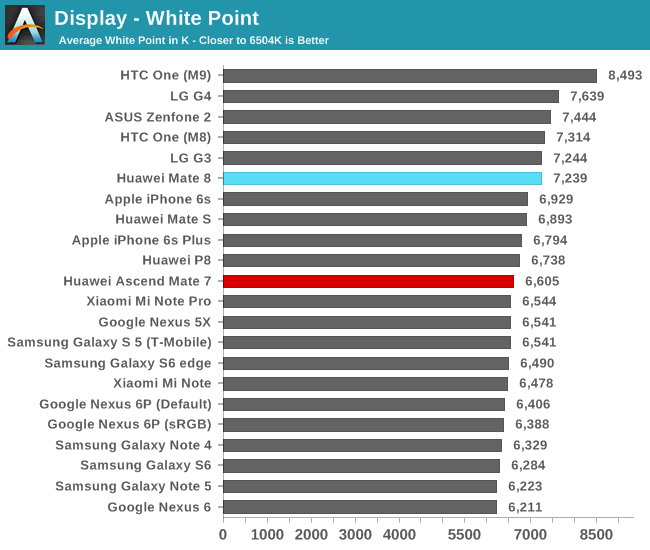
While the Mate 7 averaged a colour temperature default of 6605K (with very green whites), the Mate 8 is configured at a higher 7239K, displaying colder whites that tend towards blue. For people who like to adjust colour temperature Huawei again exposes a control slider for this. Unlike the P8 where you could hit outstanding display accuracy when configuring the slider to the warmest possible value, the Mate 8 is again a shot in the dark as hitting 6504K is a quite difficult task without proper display calibration equipment.
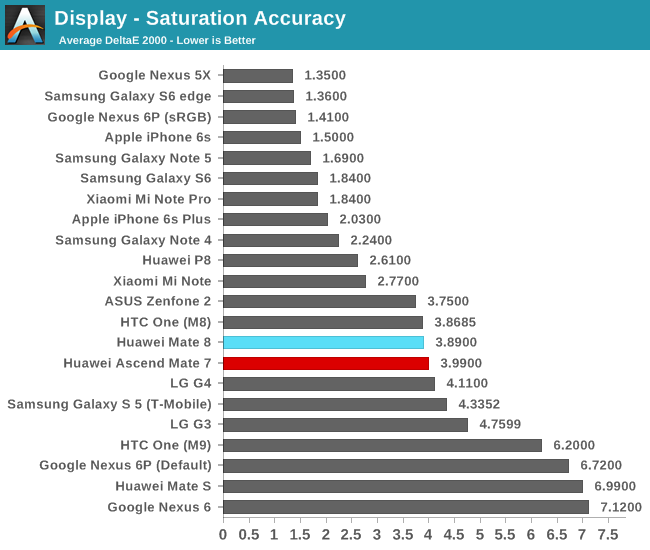
The Mate 8 comes with a wide gamut display calibration and thus saturation accuracy against our sRGB target is quite off with a dE2000 of 3.89. I wasn’t able to determine to what standard Huawei tried to calibrate the gamut to as it doesn’t match either DCI nor AdobeRGB, so it must either be the panel’s native gamut or some other standard we haven’t tested yet.
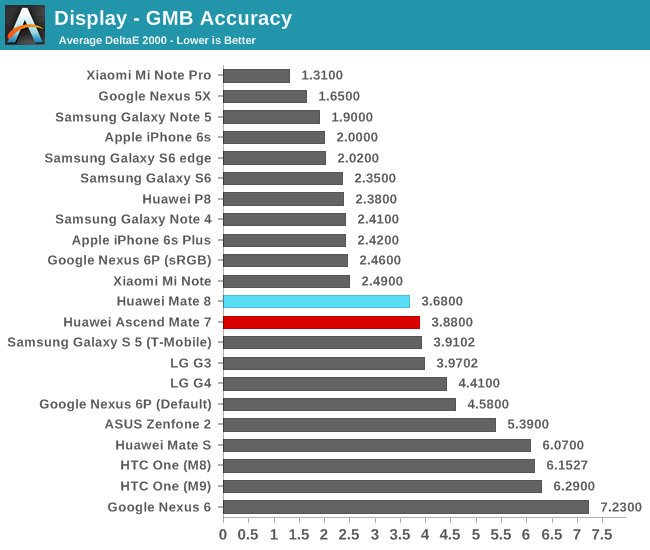
Finally the Gretag McBeth benchmark of commonly encountered colours such as skin tones of foliage shows a dE2000 of 3.68 which is slightly better than that of the Mate 7. As seen in our colour comparison strip, it seems that it’s especially the higher gamma which has an effect on the perceived colours as they’re all darker than the targeted values.
Overall the Mate 8 is a good screen. It seems that Huawei deliberately didn’t calibrate it for more accurate colours as it’s likely the general populace prefers wider gamuts with more saturated colours. Still the screen represents some improvements over the Mate 7 – it’s a brighter and more homogenous display (on our review samples) and it also fixes the green tint observed in last year’s device. Given the screen size it’s reasonable for Huawei to have gone with an LCD screen, although after seeing the Mate S I would like to see an eventual switch to AMOLED, that is if they’re able to choose an efficient panel. The 1080p resolution on the 6” screen is also somewhat outmatched in sharpness by competing devices, so again while this is a subjective matter, it’s definitely something to consider, especially when one is used to read with the device close up.
Display Power
As mentioned before, going with an LCD panel is required if one is focused on battery life as AMOLED displays still haven’t quite reached sufficient efficiency levels to say that they always outperform LCD screens. The Mate 8’s 6” screen is especially prone to this as going AMOLED would have increased peak power quite a lot, as well as considerably increasing the device’s bill of materials.
| Screen Luminance Power Efficiency 100% APL / White |
||||||
| Device | Screen Luminance Power at 200cd/m² |
Luminance Power (mW) / Screen area (cm²) Efficiency |
||||
| Huawei Ascend Mate 7 | ~379 mW | ~3.82 | ||||
| LG G4 | 354 mW | 4.11 | ||||
| Meizu MX4 | 345 mW | 4.14 | ||||
| Huawei Mate 8 | ~419 mW | ~4.22 | ||||
| Huawei P8 | ~341 mW | ~4.43 | ||||
| Meizu MX4 Pro | 386 mW | 4.47 | ||||
| Samsung Galaxy Note 5 | 504 mW | 5.64 | ||||
| Samsung Galaxy S6 | 442 mW | 5.99 | ||||
| Huawei Nexus 6P | ~615 mW | ~6.88 | ||||
| Samsung Galaxy S5 | 532 mW | 7.21 | ||||
| Samsung Galaxy Note 4 | 665 mW | 7.22 | ||||
| Samsung Galaxy S5 LTEA | 605 mW | 8.20 | ||||
| LG Flex 2 | 765 mW | 8.89 | ||||
| Samsung Galaxy S4 | 653 mW | 9.22 | ||||
| Huawei Mate S | ~769 mW | ~9.24 | ||||
For this test I went ahead and measured the luminosity curve on the Mate 7 as well so that we can have a comparison between the two device generations, and oddly enough it seems that the Mate 8 actually regressed in efficiency. Due to not having the opportunity to dismantle the device and hook up my power measurement equipment to it, I thus had to rely on the device’s own fuel-gauge. While this seemed seemingly accurate for the CPU and GPU figures, it’s odd to see the Mate 7 actually outperform screens such as LG’s latest generation panel in the G4 but may very well be possible due to the lower pixel density allowing better light transmission through the screen’s TFT matrix.
The Mate 8 seems to fall more in line with other measurements of LCD devices, displaying an estimated luminance power efficiency of ~4.22 mW of power for each cm² of screen area. At full brightness the Mate 8 uses 1541mW, of which ~1140mW can be attributed to the backlight.
Overall the Mate 8’s screen efficiency lands where we expected it to be for an LCD display and thus should be able to allow the device to perform well in our battery benchmarks.



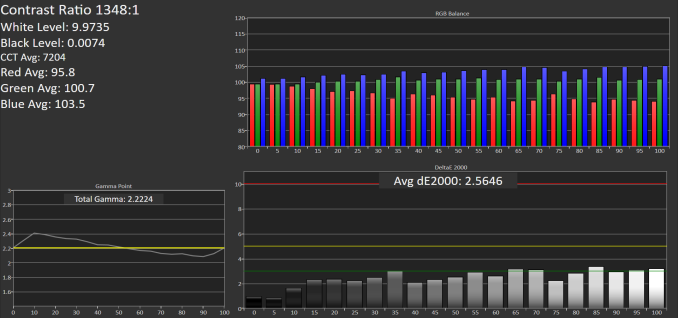

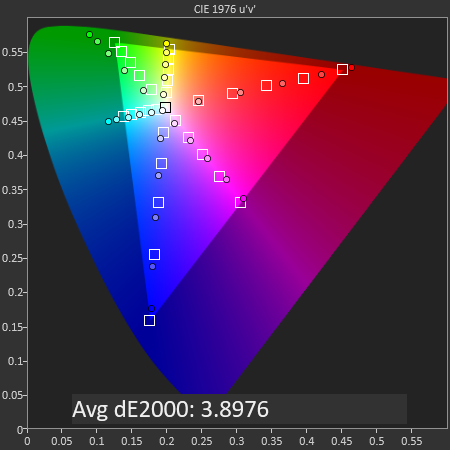


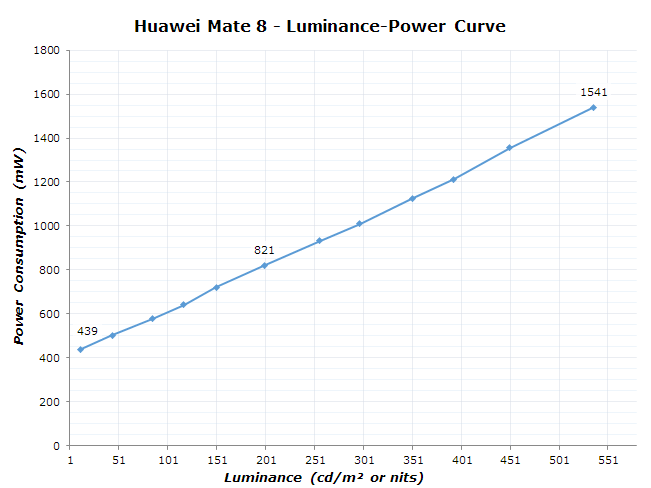








116 Comments
View All Comments
UtilityMax - Tuesday, January 5, 2016 - link
Like iPhone is not made in China..fanofanand - Wednesday, January 6, 2016 - link
My post was not in reference to the country the phone is built in (I have never owned a single apple product BTW) but rather the country that is designing this phone. The Chinese don't exactly have a reputation for quality. See the Bahamian resort in bankruptcy because of incompetent Chinese builders. As a perfect example. The long term durability of apple products are a known quantity, the same cannot be said for Huawei. My point was, you need to provide a compelling reason (price) to entice enough people to gain traction. This is like trying to go 0-60 instantly.MobiusPizza - Wednesday, January 6, 2016 - link
That is stereotyping to the extreme.If apple products are known for quality, explain antenna gate, yellowing Macbook screens and overheating Nvidia GPUs in Macbook. My point is, the country it is designed in may have historically associated with cheao quality, but doesn't mean every thing would be. For every one competent engineer in the west you can find 10 in China. The historical fact that smaller Chinese companies weren't focused on quality but more on quantity was not due to Chinese people lacking design expertise, but was driven by world demand in cheap products. Nowadays, especially big Chinese companies with stake in brand image, are much more quality focused since even local market , the more affluent Chinese general population, are increasingly demanding higher quality products. The shift is rapid.
A recent independent blinded tests for example of Japanese vs Chinese made rice cooker for example resulted in no perceived quality difference.
s.yu - Saturday, January 16, 2016 - link
Which blind test? I only noticed the laughable CCTV tests done by Chinese officials. That was a good laugh, really.ddriver - Wednesday, January 6, 2016 - link
Your view is bigoted and narrow-minded - the chinese can build lousy quality and they can build good quality - whatever the customer wants and pays for.Sure, there is that thing where a lot of companies seek to manufacture in China for the low manufacturing cost, enabling low purchase cost, thus quality is compromised for the sake of pricing.
But all in all, the chinese are capable of producing as high quality products as anyone else. It is not rocket science. Whether on not it is quality is not a subject of expertise but to whether or not you want quality.
jasonelmore - Wednesday, January 13, 2016 - link
we taught the Chinese how to make a good phone. In the case of the iphone, Apple gave them the tools, and knowledge on how to produce a quality product. it was a partnership. Apple shipped all their CNC milling machines (apple bought out the CNC Manufacturing industry for 5 years, nobody else could buy one). They are also a stake holder in many of the Foxconn factories (because they helped build them due to their volume purchase orders).Chinese have cheap labor, and many engineers, and they have towns built around electronics manufacturing. To say they did this all on their own is not true.
invinciblegod - Wednesday, January 13, 2016 - link
Exactly! It's exactly like how Japan learned how to build cars from the US companies, and now everything Japan makes can be wholly contributed to US expertise!invinciblegod - Wednesday, January 13, 2016 - link
/sarcasms.yu - Saturday, January 16, 2016 - link
lol good one.levizx - Wednesday, January 6, 2016 - link
So, who DESIGNED the "Bahamian resort"? Apparently "Chinese builders" shouldn't matter, incompetent or whatever, so that can't be "a perfect example" as you explicitly pointed out in Apple's case.